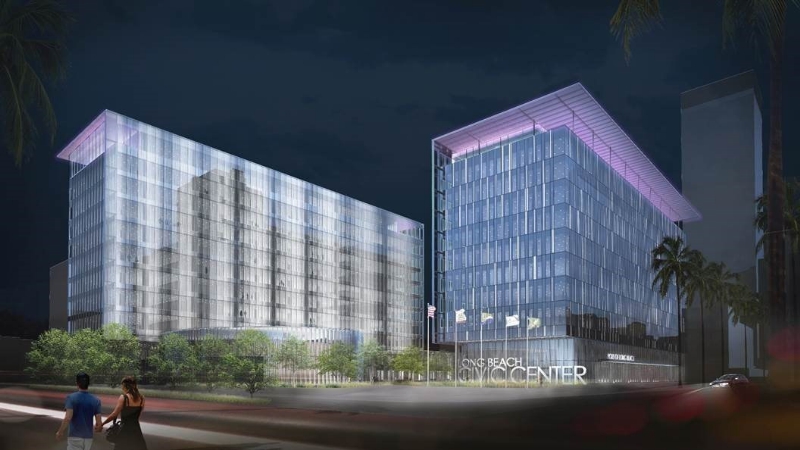Arup announced that the City of Long Beach and Port of Long Beach have reached financial close for the $520 million Long Beach Civic Center Project.
The project includes a new city hall, port HQ, main library, public park, and street improvements. All the features are designed to be occupied within a week of a major earthquake and meet REDi Gold earthquake performance, an operational resilience rating system developed by Arup.
A public-private partnership (P3) was used to fund the project, which combines public infrastructure and private mixed-use real estate development into one design-build-finance-operate-maintain arrangement.
Arup, the global interdisciplinary consulting and design services firm, served as lead advisor to the city and Port of Long Beach. The firm led financial, commercial, real estate, design, engineering, and cost consulting advisory services.
 Long Beach, Calif. Photo: Zen Skillicorn/Creative Commons.
Long Beach, Calif. Photo: Zen Skillicorn/Creative Commons.
The Arup team included HOK for architecture consulting, BAE for real estate economics, and MBI Media for outreach. Sheppard Mullin provided legal advice to the owners.
Plenary Group is the lead P3 developer, sole equity provider, and financial arranger for the consortium, which includes Clark Construction, Edgemoor, Johnson Controls, and SOM.
Allianz, in a private placement, is providing $237 million in long-term financing. Sumitomo Mitsui Banking Corp. is providing a $213 million loan. Long Beach would contribute $11.8 million in cash and land valued at nearly $30 million. Plenary is contributing $21 million in equity.
Arup managed the entire process from the RFP to the end of negotiations and helped the project become a reality quicker than expected.
"A significant value added for the city is how the P3 model accelerated what would more conventionally have been a three- to five-year project development process using traditional project delivery methods to a two-year process," Orion Fulton, Arup's project team leader, said.
Arup has served as an advisor for numerous projects, including Presidio Parkway in San Francisco, the Los Angeles Convention Center, and the New Champlain Bridge in Quebec.
Construction has begun, and the next phase of the project is being launched.
Related Stories
| Feb 22, 2011
Military tests show copper increases HVAC efficiency, reduces odors
Recent testing, which is being funded by the Department of Defense, is taking place in military barracks at Fort Jackson, South Carolina. Side-by-side comparisons demonstrate that air conditioning units made with copper suppress the growth of bacteria, mold, and mildew that cause odors and reduce system energy efficiency.
| Feb 11, 2011
Justice center on Fall River harbor serves up daylight, sustainable elements, including eucalyptus millwork
Located on historic South Main Street in Fall River, Mass., the Fall River Justice Center opened last fall to serve as the city’s Superior and District Courts building. The $85 million facility was designed by Boston-based Finegold Alexander + Associates Inc., with Dimeo Construction as CM and Arup as MEP. The 154,000-sf courthouse contains nine courtrooms, a law library, and a detention area. Most of the floors have the same ceiling height, which will makes them easier to reconfigure in the future as space needs change. Designed to achieve LEED Silver, the facility’s elliptical design offers abundant natural daylight and views of the harbor. Renewable eucalyptus millwork is one of the sustainable features.
| Feb 7, 2011
GSA Unveils New Sustainable Workplace Design Tool
The U.S. General Services Administration launched its Sustainable Facilities Tool on Monday, Feb. 7. The innovative online tool will make it easier for both government and private-sector property managers and developers to learn about and evaluate strategies to make workplaces more sustainable, helping to build and create jobs in America’s clean energy economy of the future.
| Jan 21, 2011
Combination credit union and USO center earns LEED Silver
After the Army announced plans to expand Fort Bliss, in Texas, by up to 30,000 troops, FirstLight Federal Credit Union contracted NewGround (as CM) to build a new 16,000-sf facility, allocating 6,000 sf for a USO center with an Internet café, gaming stations, and theater.
| Jan 21, 2011
Sustainable history center exhibits Fort Ticonderoga’s storied past
Fort Ticonderoga, in Ticonderoga, N.Y., along Lake Champlain, dates to 1755 and was the site of battles in the French and Indian War and the American Revolution. The new $20.8 million, 15,000-sf Deborah Clarke Mars Education Center pays homage to the French magasin du Roi (the King’s warehouse) at the fort.
| Jan 21, 2011
GSA Recognizes the Best in Public Architecture
The U.S. General Services Administration recognized the best in public architecture and civilian federal workplaces at the 2010 GSA Design Awards in Washington, D.C. This year's 11 award winners showcase the federal government's commitment to cutting-edge architectural design and its focus on sustainability.
| Jan 19, 2011
New Fort Hood hospital will replace aging medical center
The Army Corps of Engineers selected London-based Balfour Beatty and St. Louis-based McCarthy to provide design-build services for the Fort Hood Replacement Hospital in Texas, a $503 million, 944,000-sf complex partially funded by the American Recovery and Reinvestment Act. The firm plans to use BIM for the project, which will include outpatient clinics, an ambulance garage, a central utility plant, and three parking structures. Texas firms HKS Architects and Wingler & Sharp will participate as design partners. The project seeks LEED Gold.
| Jan 4, 2011
Product of the Week: Zinc cladding helps border crossing blend in with surroundings
Zinc panels provide natural-looking, durable cladding for an administrative building and toll canopies at the newly expanded Queenstown Plaza U.S.-Canada border crossing at the Niagara Gorge. Toronto’s Moriyama & Teshima Architects chose the zinc alloy panels for their ability to blend with the structures’ scenic surroundings, as well as for their low maintenance and sustainable qualities. The structures incorporate 14,000 sf of Rheinzink’s branded Angled Standing Seam and Reveal Panels in graphite gray.













